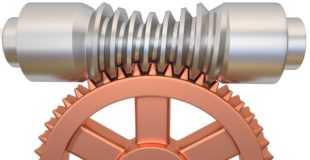https://i.ytimg.com/vi/OVTOSOKpx6I/hqdefault.jpg
In this tutorial, you will learn how to create a globoid worm shaft and its mating gear wheel in Blender 3D, and test their compatibility using Blender’s Rigid Body Physics engine.
For more free tutorials and 3D models, and to make a donation, please visit www.otvinta.com.
source

38 responses to “Tutorial: How to Model Globoid (aka Throated) Worm Drive in Blender”
Excelente.
Ha sido de una gran ayuda el aporte que ha hecho con este video.
Thank you for this! Not only it was useful for modelling, but it was a good way to learn how rigid body physics work.
this tools empower people to build their dreams
When I follow the tutorial to the point at 8:58 – the origin of my object does not follow the 3D cursor like it does in the video. If I move it maually by using the set origin/origin to 3D cursor action, then I can get the duplicate to rotate around the center at Xaxis 29 – but all other objects created also do not automatically move the origin, such as the tooth meshes. Art 13.49 when I go into edit mode, the origin is inside the object, and in object mode, it is at the 3D cursor. I had to mess around and set the origin manually for every duplicate. When I get to the end – the simulation fails. I noticed that the teeth of the wheel also merge with the worm still after a -1% scale. So question is whether there is some setting that automatically moves the pivot/origin to the 3D cursor – or some difference in how blender orientates origins i earlier versions – or if the tooth size is causing my simulation to fail? I'm using blender 2.79.
It's cool ! Why your calculator isn't use for the wheel also ?
in 14:37 you can use shift+R several times to repeat last step (copy+rotate), or you can use array modifier and copy and rotate object around empty – with auto merge. Anyway – thanks for you work and sharing
Do you intend to make a tutorial about cylindrical worm drive?
Great tutorial! Does Tooth Height Falloff always need to be 5 or should it be compared to another parameter?
I want to design small diameter globoid (wheel diameter ~ 10 mm). In my case the worm moves with the fingers and the wheel axle almost does not provide resistance (on it there is a small mirror that needs to be precisely set in a certain angle). Is it necessary to change change some parameters in the globoid design to gain as much self-lock feature as possible?
Life Achievement. In blender. I understood everything. subject aside, best blender tutorial ever. Thank you very much!
great tutorial, learned alot, just wondering though, is there anyway to speed up the gear/animation? mine seems really slow
You can't obtain the true gear wheel surface through this method.
14:27 Alt-R can be used to do repeated rotation around the object's center (or any center by modifying the property's settings. It takes a little finesse and practice but will save some time.
Cool – looks like motorcycle wheel.
This is exactly what I was looking for.
Instead of rebuilding it the complete way I just took the printable Stl version and made some changes with blender to fit my needs. Works and looks wonderful. Thank you 👍
Hi, I like your tutorial, and I made this in Blender 2.7.8.a, and at frame 250 it stops, can you please tell me why? I tried 1000, 750 and then 500, but the same result….
YOU ARE SO AWESOME…………
THANK YOU ; )
could u put the link to the formulas in print
when making the globiod gear the mouth thing does not work on all types of worm. Why is that and what is required for that to work ?
This amazing! Why dont you write scripts in Python for blender?
what happen to your voice!
alternatively, you can use a gear and the inner part of a torus, animate them rotating, and have the gear be a brush that pushes the torus edges inwards using dynamic paint
Can you make a tutorial on how to make helical gears?
не хуя не понятно
How did you determine the ratio between the worm drive and gear.
this is great, but i have one question. why the hell is this working. the radius decreases to the mittle, something that should cause the center to rotate slower than the edges. should this not cause complications?
Nice work! I managed to make one with (4t/40t). I scaled down the worm to 0.98, but I still had to move the wheel, hinge2 & axis2 + 0.5mm on X axis before the animation started to work properly.
I have been struggling to do this in some other softwares before (some other techniques). I felt Blender light as feather.
those tutorials are awesome, please do more of them if you have some spare time.
Потрясающе мощно! Почему я раньше такого не видел?
Fantastic. I wonder if the calculator could generate full python script for blender to avoid the manual work between calculator and blender.
why my animation stop after frame 9 ?
can we scale gear and worm little small so I can use it in some my other mechanical model like oil pump or something?
this is what Im looking for Please upload more
Fantastic tutorial, Thaks.
Just a suggestion, why not put the link to the "calculator" in Your description as well?
Brgds.
I think the Globoid worm is correct. But the gear wheel tooth surface is not. If you email me 3d CAD model of the gear wheel tooth anf the worm tooth I can point on errors.http://spiralbevel.com/globoid
This is so helpful please bring more thanks
Nice job.